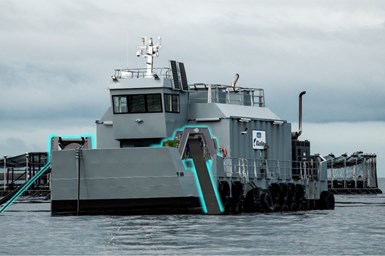ACS-A to develop composite prototypes, processes for MoorPower wave energy project
The two-year, Australia-based demonstrator project aims to use wave energy conversion technology to decarbonize offshore aquaculture operations.
Launched in October 2021, the two-year, $3.4 million MoorPower scaled demonstrator project aims to decarbonize offshore aquaculture operations by developing wave energy converter (WEC) technology for installation on board moored feeding barges that currently run on diesel fuel generators.
An artist’s impression of Carnegie Clean Energy’s new wave-powered product incorporated onto a feeding. Photo Credit: ACS-A
Project leader Carnegie Clean Energy (North Fremantle, Australia) will operate the MoorPower technology at its research facility in Western Australia. The project is funded with support from the Blue Economy Cooperative Research Centre (CRC, Newnham, Tasmania, Australia) and in collaboration with partners Advanced Composites Structures Australia (ACS-A, Port Melbourne, Victoria, Australia), Huon Aquaculture, Tassal Group, DNV GL Australia, University of Tasmania, Climate KIC, Australian Ocean Energy Group, AMC Search and the University of Queensland.
Composites fabricator ACS-A says it is currently working on composite part prototypes and processes for the project.
The MoorPower project concept was developed by Carnegie Clean Energy with the goal of decarbonizing the energy needs of offshore operations, particularly in the aquaculture industry. According to ACS-A, MoorPower is similar in concept to Carnegie’s “CETO” wave energy conversion technology, but instead of a submerged buoy which sits a few meters below the surface of the ocean, the new system moves with the motion of the waves. This orbital motion drives a power take-off (PTO) system, which converts the wave motion into electrical energy.
Related Content
-
Achieving composites innovation through collaboration
Stephen Heinz, vice president of R&I for Syensqo delivered an inspirational keynote at SAMPE 2024, highlighting the significant role of composite materials in emerging technologies and encouraging broader collaboration within the manufacturing community.
-
Composites end markets: Batteries and fuel cells (2024)
As the number of battery and fuel cell electric vehicles (EVs) grows, so do the opportunities for composites in battery enclosures and components for fuel cells.
-
Infinite Composites: Type V tanks for space, hydrogen, automotive and more
After a decade of proving its linerless, weight-saving composite tanks with NASA and more than 30 aerospace companies, this CryoSphere pioneer is scaling for growth in commercial space and sustainable transportation on Earth.

.jpg;width=70;height=70;mode=crop)











